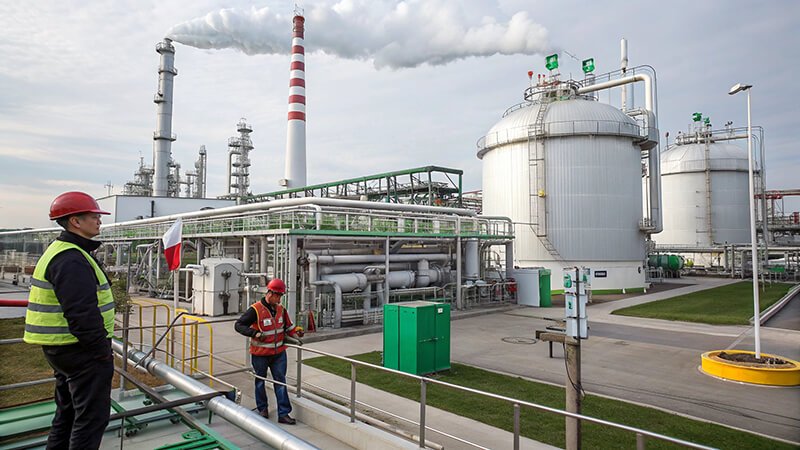Frustrated by inconsistent product quality? Wondering how a liquid's flow affects your bottom line? Understanding viscosity is often the solution you need for better results.
Viscosity is a key property affecting countless industrial products and processes. It dictates how liquids flow, influencing everything from production efficiency and product stability to final quality and even user experience.
You might be surprised at just how many sectors rely on this fundamental property. I've seen firsthand how a good grasp of viscosity can transform operations for businesses, much like my customer Jacky from Italy, who needs consistent quality for the lab instruments he distributes. Understanding these applications can highlight areas for improvement in your own operations. Let's explore some key examples.
How is viscosity a critical factor in the Oil and Gas Industry?
Drilling challenges slowing you down? Facing issues with oil flow or equipment wear? Proper viscosity management is vital for smooth operations in oil and gas.
In the oil and gas sector, viscosity is crucial for drilling fluid performance, efficient crude oil transport, optimal lubricant function, and precise refining processes, directly impacting safety and profitability.

The oil and gas industry relies heavily on precise viscosity measurements at various stages. I've worked with clients who found that controlling viscosity helped them overcome significant operational hurdles.
Drilling Fluids and Muds
The viscosity of drilling fluids, or muds, is a make-or-break parameter. It determines the fluid's ability to carry rock cuttings out of the wellbore. If the viscosity is too low, cuttings fall back and can cause the drill string to get stuck. If it's too high, it can create excessive pressure downhole. Proper viscosity also helps stabilize the wellbore walls, cool and lubricate the drill bit, and balance formation pressures. We at Martests understand that reliable viscometers are essential here.
Crude Oil Transportation
Crude oil viscosity directly impacts its flowability through pipelines. Heavier, more viscous crudes often require heating or the addition of viscosity-reducing agents for efficient transport. I recall a distributor mentioning how their end-users optimized pumping strategies based on accurate viscosity data, saving energy and reducing wear on equipment.
Lubricants and Fuels
For lubricants, viscosity is perhaps their most important property. It dictates the strength of the oil film that separates moving parts in engines and machinery, reducing friction and wear. Fuel viscosity, on the other hand, affects atomization during injection and, consequently, combustion efficiency.
Refining Processes
During refining, the viscosity of different oil fractions is a key quality control parameter. It helps classify products and determine their suitability for various applications. Consistent measurement ensures product grades meet specifications.
Why is precise viscosity control essential in the Food and Beverage Industry?
Are your food products inconsistent in texture? Struggling with processing issues like clumping or uneven filling? Viscosity is often the secret ingredient to perfect food and beverage production.
Viscosity control in the food industry is key for desired product texture and mouthfeel, smooth production processes like mixing and filling, ensuring product stability, and achieving perfect baking results.

In my experience, especially when talking to customers who supply to food processing plants, viscosity is paramount. It touches almost every aspect of how food is made and enjoyed.
Product Texture and Mouthfeel
Think about your favorite sauce, yogurt, or juice. Their characteristic thickness and flow – their viscosity – are critical to how you perceive their quality and enjoyment. For example, a ketchup that’s too runny or a syrup that’s too thick can be disappointing. Manufacturers meticulously control viscosity to meet consumer expectations for products like sauces, dairy items, beverages, chocolate, and soups.
Production Process Control
Viscosity is vital for efficient food processing. During mixing, pumping, filling, and spraying, the material's flow behavior must be predictable. For instance, chocolate needs the right viscosity to fill molds correctly and cool evenly. The viscosity of tomato paste determines how easily it flows from a bottle. We provide viscometers that help our clients ensure these processes run smoothly.
Stability
Many food products are suspensions or emulsions. Viscosity plays a role in keeping solid particles suspended or oil and water phases from separating. A stable viscosity helps prevent ingredients from settling or the product from splitting over time, ensuring a longer shelf life and consistent quality.
Baking
In baking, the viscosity of batters and doughs is crucial. It affects how they expand during proofing and baking, how they hold their shape, and the final texture and structure of the baked goods.
What impact does viscosity have on Cosmetics and Personal Care products?
Do your creams feel too greasy or too watery? Is product dispensing a challenge for your customers? The luxurious feel and performance of cosmetics often boil down to viscosity.
Viscosity in cosmetics dictates product performance like spreadability and absorption, ensures stability by preventing separation, and critically influences the sensory experience, directly impacting consumer satisfaction and brand loyalty.

The cosmetic and personal care industry is all about user experience. I've had many conversations with distributors whose customers emphasize how the "feel" of a product, largely determined by its viscosity, is a major selling point.
Product Performance
The viscosity of products like creams, lotions, shampoos, conditioners, toothpaste, and gels is fundamental to their function. It affects how easily a product spreads on the skin or hair, how quickly it's absorbed, its ability to adhere to a surface, and even how conveniently it can be dispensed from its container. For example, a face cream needs to be viscous enough to stay on your fingers but spread smoothly on your skin.
Stability
Many cosmetic products are emulsions or suspensions. Proper viscosity is essential to keep these formulations stable, preventing ingredients from separating, creaming, or caking during storage or use. An unstable product not only looks unappealing but can also lose its efficacy. This is a key concern for brands that want to maintain a high-quality image, a point Jacky often makes when discussing his private label needs.
Sensory Properties
The "hand-feel" or "skin-feel" of a cosmetic product is largely governed by its viscosity. A lotion might feel silky, a gel refreshing, or a cream rich and emollient – these tactile sensations are critical to the user's perception and satisfaction. Manufacturers spend considerable effort optimizing viscosity to achieve the desired sensory profile.
How does viscosity influence processes and products in the Pharmaceutical Industry?
Facing issues with drug delivery consistency or manufacturing uniformity? Could incorrect fluid properties be compromising patient outcomes? Viscosity is a silent guardian in pharmaceutical quality and efficacy.
In pharmaceuticals, viscosity impacts drug delivery accuracy and absorption rates, is a key control parameter in manufacturing processes like coating and filling, and ensures the stability and uniformity of medications.

The pharmaceutical industry operates under stringent quality standards, and viscosity control is non-negotiable. My clients who supply instruments to this sector always highlight the need for utmost precision.
Drug Delivery
The viscosity of pharmaceutical formulations like oral liquids, injectables, eye drops, and ointments is critical. It affects how accurately a dose can be administered, the rate at which the drug is absorbed by the body, and even patient comfort and compliance. For instance, an injectable solution that is too viscous can be difficult and painful to administer. An eye drop that is too thin might not stay in the eye long enough.
Production Process Control
During pharmaceutical manufacturing, viscosity is a key parameter in various processes. This includes coating tablets, preparing suspensions, and filling vials or syringes. Controlling viscosity ensures production efficiency and, more importantly, the uniformity and quality of the final drug product. Consistent viscosity helps achieve uniform coating thickness or accurate fill volumes.
Stability
Many medications are suspensions or emulsions. Viscosity plays a crucial role in maintaining the uniform distribution of active pharmaceutical ingredients (APIs) within the liquid or semi-solid base. It also contributes to the long-term stability of the formulation, preventing settling or separation of components, which could lead to incorrect dosing. Our viscometers at Martests are designed to provide the reliable data needed for such critical applications.
In what ways is viscosity pivotal for the Paints, Inks, and Adhesives Industry?
Are your coatings uneven or prone to sagging? Do your inks cause printing defects? Is adhesive bonding strength inconsistent? Viscosity is the key to high-performance applications.
For paints, inks, and adhesives, viscosity determines coating properties like flow and coverage, affects adhesive bonding strength by influencing wetting, and directly impacts printing quality, including clarity and drying time.

When I talk to distributors like Jacky, who might have customers in the industrial coatings or printing sectors, the conversation often turns to application properties. Viscosity is at the heart of this.
Coating Performance (Paints & Inks)
The viscosity of paints and inks is fundamental to their application and final appearance. It determines how well they flow and level on a substrate, their resistance to sagging on vertical surfaces, their hiding power, the uniformity of the film thickness, and even their drying speed. Whether applying by spraying, brushing, rolling, or printing, the right viscosity is essential for a successful outcome. An ink with incorrect viscosity might bleed or not transfer properly.
Adhesion (Adhesives)
For adhesives, viscosity influences several critical factors related to bonding. It affects the adhesive's ability to wet the substrate – that is, to spread out and make intimate contact. It also impacts how deeply the adhesive can penetrate porous materials. Both wetting and penetration are crucial for achieving strong and durable bonds. The "open time" or "working life" of an adhesive is also often related to its viscosity changes over time.
Printing Quality (Inks)
In the printing industry, ink viscosity is a direct factor in print quality. It affects the sharpness and clarity of printed images, the saturation of colors, and how quickly the ink dries on the substrate. Different printing processes (e.g., flexography, gravure, screen printing) require inks with very specific viscosity ranges to perform optimally. Consistent viscosity ensures consistent print results, which is vital for packaging and publications.
How is viscosity managed and why is it important in the Chemical and Polymer Industry?
Struggling with inefficient chemical reactions or inconsistent polymer grades? Are material processing challenges impacting your output? Viscosity is a fundamental parameter for control and quality.
In the chemical and polymer industry, viscosity affects reaction efficiency and product quality, serves as a key indicator in polymerization processes, and is critical for trouble-free processing of materials like plastics and rubbers.

The chemical and polymer industries are incredibly diverse, but one common thread is the importance of fluid and melt behavior. We at Martests provide robust viscometers that can handle the varied demands of these sectors.
Reaction Processes
In many chemical reactions, especially those involving liquids, the viscosity of the reactants can significantly impact mixing efficiency. Good mixing is often essential for effective mass and heat transfer, which in turn influences the reaction rate, yield, and selectivity towards the desired product. If reactants are too viscous, it can be hard to mix them properly.
Polymerization Processes
During polymerization, the molecular weight and molecular weight distribution of the forming polymer directly influence the viscosity of the polymer solution or melt. Monitoring viscosity is a common and effective way to track the progress of a polymerization reaction and to ensure the final polymer meets quality specifications. It’s a critical quality control point. I've seen how this helps our clients maintain batch-to-batch consistency.
Product Processing
The processing of polymers into final products – like plastics, rubbers, and fibers – heavily relies on controlling melt viscosity. Processes such as extrusion, injection molding, and fiber spinning require the polymer melt to have a specific viscosity range to ensure proper mold filling, dimensional stability, and the desired final properties of the product.
Fluid Transport
Chemical plants involve the transport of a vast array of fluids – raw materials, intermediates, final products, and solvents. Accurate viscosity data is essential for designing and optimizing pumping systems, mixing equipment, and pipelines, especially when dealing with corrosive, volatile, or high-viscosity liquids.
Why is viscosity a key consideration for performance and reliability in the Automotive Industry?
Experiencing premature engine wear or sluggish system responses in vehicles? Could fluid properties be the culprit? In the automotive world, viscosity is engineered for optimal performance and protection.
Viscosity in the automotive industry is vital for engine and transmission lubrication across varying temperatures, ensures efficient operation of brake and hydraulic systems, and influences fuel atomization for better combustion.

The automotive industry demands high performance and reliability, and the fluids used are critical. When I discuss with clients who supply to automotive component manufacturers, the conversation always includes how fluid viscosity impacts longevity and efficiency.
Engine Oils and Transmission Fluids
The viscosity of engine oil is paramount for protecting an engine. It must be thin enough to flow quickly at cold start-ups but thick enough to maintain a protective film at high operating temperatures. This behavior across temperatures is described by the "viscosity index." Viscosity index improvers are additives used to achieve this balance. Similarly, transmission fluids need specific viscosities for smooth gear changes and component protection.
Brake Fluids and Hydraulic Fluids
Brake fluids and other hydraulic fluids in a vehicle must maintain a relatively stable viscosity over a wide temperature range. This ensures that the braking system and other hydraulic systems (like power steering) respond quickly and efficiently under all conditions. If the viscosity is too high at low temperatures, response can be sluggish; if too low at high temperatures, it can lead to leaks or loss of pressure.
Fuel
The viscosity of fuels like gasoline and diesel affects their atomization when injected into the engine cylinders. Proper atomization is crucial for efficient combustion, which in turn impacts fuel economy, power output, and emissions. Fuel viscosity needs to be within a specific range for injectors to work correctly.
How does viscosity affect the application and quality of Construction Materials?
Are your cement mixes difficult to pump or apply? Is your asphalt cracking prematurely? The workability and durability of many construction materials depend heavily on their viscosity.
Viscosity influences the pumpability and workability of cement slurries and mortars, and it is a key indicator of asphalt performance at different temperatures, impacting road quality and durability.
Even in an industry as robust as construction, the flow properties of materials are surprisingly important. My distributors who cater to this sector emphasize the need for materials that are easy to work with yet perform durably.
Cement Slurries and Mortars
The viscosity of cement slurries, concrete mixes, and mortars is critical for their application. It affects how easily they can be pumped to where they are needed, how well they flow to fill forms or level out, and their overall "workability" for masons and concrete finishers. If the mix is too thick, it's hard to handle and place. If it's too thin, it may not hold its shape or could lead to segregation of aggregates, weakening the final structure.
Asphalt
For asphalt, used in road paving and roofing, viscosity is a key indicator of its performance across a range of temperatures. At high temperatures during application, asphalt needs to be fluid enough to be mixed with aggregates and laid down smoothly. Once in place, its viscosity at service temperatures determines the road's ability to resist deformation (like rutting) under traffic loads and to resist cracking at low temperatures. Testing asphalt binder viscosity helps engineers select the right grade for specific climatic conditions and traffic loads. We at Martests see a growing demand for reliable viscometers in this area as infrastructure quality becomes ever more critical.
Conclusion
Viscosity clearly plays a vital role across many industries. Precise measurement ensures product quality, efficiency, and reliability, from initial formulation to final application.


